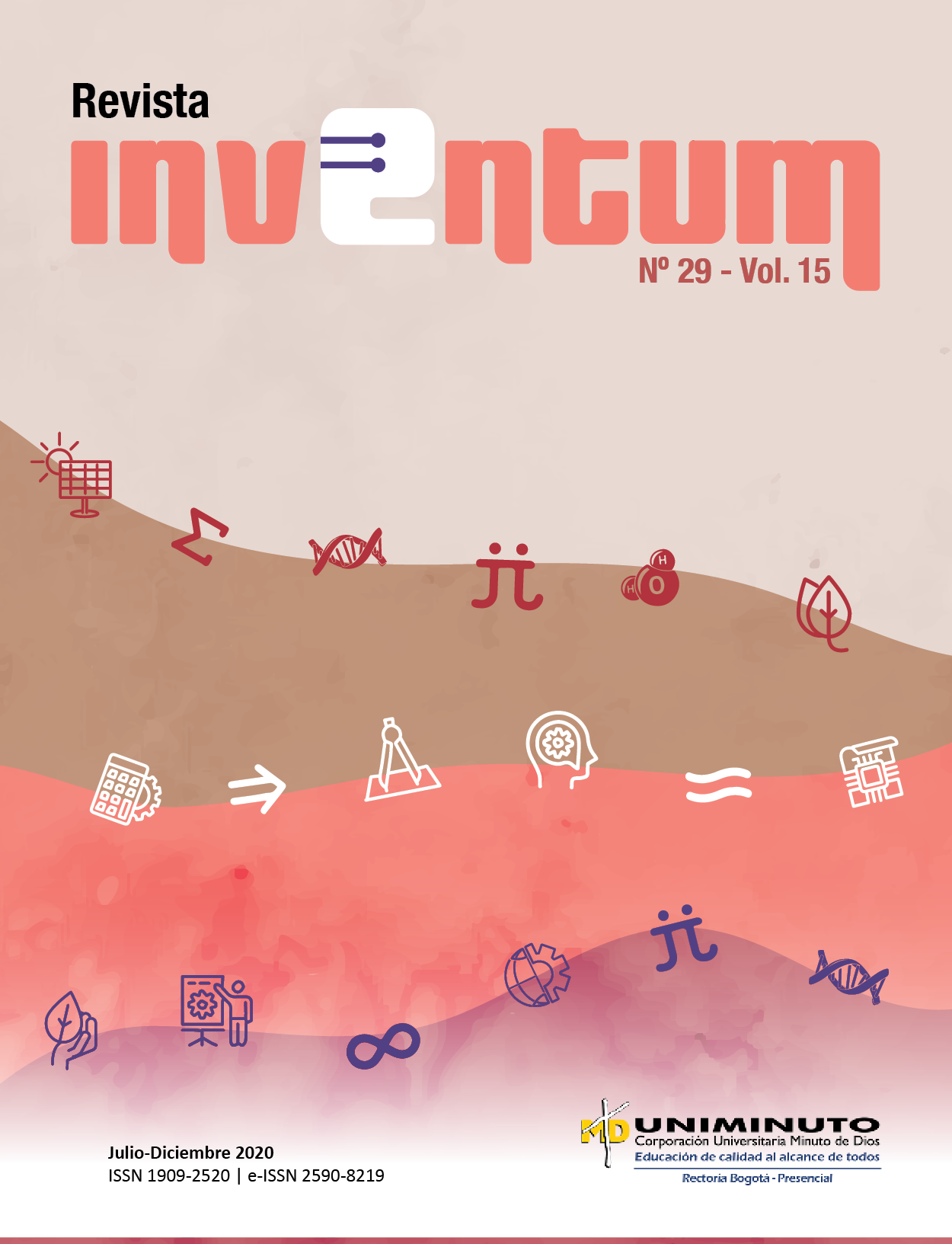Diseño hidrológico de un sistema VAC para la finca el Caimo ubicada en el municipio de Villa de Leyva, Boyacá
Contenido principal del artículo
Resumen
Este artículo propone mejorar la productividad del agroecosistema de la finca El Caimo, ubicada en el municipio de Villa de Leyva, Boyacá, al rehabilitar su sistema de producción agrícola; con la implementación de un sistema agrícola integrado de cultivo que forma parte del Manual Básico de Agro-acuicultura integrada de la Organización de las Naciones Unidas para la Alimentación y la Agricultura (FAO). Se trata del sistema VAC de Vietnam del Norte, que integra los elementos que forman parte de su estructura, con ello se busca su funcionamiento y sinergia con la combinación de los elementos y su distribución en el espacio, sumado a cambios en la cobertura actual (uso del suelo) de la finca El Caimo. A partir de la elaboración de un diseño hidrológico, con el objeto de interpretar y cuantificar, mediante modelos matemáticos, los procesos naturales inmersos en la dinámica hidrológica que intervienen en el desarrollo productivo de la finca El Caimo, y de forma paralela la elaboración de un modelo de elevación digital (DEM) por medio de Sistemas de Información Geográfica (SIG) para la consulta de datos e información hidrometeorológica, y la representación de datos georreferenciados para su análisis con la utilización de un software, y así encontrar patrones de comportamiento de distintas variables, para la delimitación de la cuenca hidrográfica cercana a la finca, con el propósito de identificar puntos estratégicos para la captación natural del agua de precipitación y su descarga de agua por escurrimiento dirigida al abastecimiento natural de los componentes del sistema VAC, al tratarse de interacciones entre los sistemas climático y terrestre. Lo cual, resulta aplicable en el sistema de producción agrícola de la finca El Caimo, que se desarrolla en el manejo de un agroecosistema que requiere de la disponibilidad de recursos para su funcionamiento, entre ellos, la disponibilidad de agua y su aprovechamiento; al tratarse de un sistema socioeconómico complejo, limitado y determinado por el sistema social y político en el que se encuentra; por el valor que la economía asigna a los recursos y productos de la finca; por la falta de infraestructura vial, mano de obra, capital, tecnología e información que permite o limita la integración de los componentes que el predio ofrece, y que en conjunto contribuyen al desarrollo del proceso de producción. Situación que explica su baja productividad, consecuencia de la falta de implementación de buenas prácticas agrícolas. De esta manera se obtiene un 4 % de disminución en el potencial de escorrentía de la finca El Caimo, con un cambio en su cobertura actual, por una mayor cobertura vegetal en árboles con la siembra de especie endémica de roble andino (Quercus humboldtii) apoyada de la siembra de cultivos que frutales (mora, durazno) y hortalizas (papa) que se producen actualmente en la finca, y en concordancia con el aprovechamiento máximo de 1,475,823 L de agua de infiltración. Asimismo, el cálculo de disminución del caudal provocado por la nueva cobertura arbórea en la finca se determinó mediante el tránsito de crecientes, lo que indicó una reducción de 0,428 m3/h, y así favoreció la disposición del sistema VAC en la finca El Caimo.
Detalles del artículo
Sección
Se solicita a los autores que diligencien el documento de cesión de derechos de autor sobre el artículo, para que sea posible su edición, publicación y distribución en cualquier medio y modalidad: medios electrónicos, CD ROM, impresos o cualquier otra forma, con fines exclusivamente científicos, educativos y culturales
- La obra pertenece a UNIMINUTO.
- Dada la naturaleza de UNIMINUTO como Institución de Educación Superior, con un modelo universitario innovador para ofrecer Educación de alta calidad, de fácil acceso, integral y flexible; para formar profesionales altamente competentes, éticamente responsables y líderes de procesos de transformación social, EL CEDENTE ha decidido ceder los derechos patrimoniales de su OBRA, que adelante se detalla para que sea explotado por ésta
- El querer de EL CEDENTE es ceder a título gratuito los derechos patrimoniales de la OBRA a UNIMINUTO con fines académicos.
Cómo citar
Referencias
[2] W. Sandoval-Erazo, Diseño de obras hidrotécnicas. Sangolqui, Ediespe, 2018.
[3] Organización de las Naciones Unidas para la Alimentación y la Agricultura, Instituto Internacional para la Reconstrucción Rural,
Worldfish Center, Agro-acuicultura integrada. Manual básico. Roma, FAO/ICLARM/IIRR,2004.
[4] M. Halwart, M. Espinoza-Martínez y A. Schuckler, Los pequeños estanques, Roma, FAO, 2000.
[5] Atlas del Ideam - Boyacá, 2010. [En línea]. Disponible en: http://atlas.ideam.gov.co/basefiles/boyaca_texto.pdf. [Accedido:
22-julio-2020].
[6] L. W. Mays, Ingeniería de recursos hídricos, 3a edición. New York,Wiley, 2019.
[7] Organización de las Naciones Unidas para la Alimentación y la Agricultura, Fondo Internacional para el Desarrollo de la Agricultura, y Cooperación Suiza en América Central, Captación y almacenamiento de agua de lluvia. Opciones técnicas para la agricultura familiar
en América Latina y el Caribe. Santiago de Chile, FAO, 2013.
[8] G. A. Forero Buitrago, “La madera colombiana, oportunidad de regeneración del flujo de los ríos mediante una producción sostenible y competitiva”, Rev. Tecnol., vol. 15, no. 2, pp. 113-128, 2017. doi: 10.18270/rt.v15i2.2179.
[9] E. Gras, Cosecha de agua y tierra. México, Coas ediciones, 2009.
[10] G. Poveda and O. Mesa, “Efectos hidrológicos de la Deforestación,” ResearchGate, Dec. 1994. https://www.researchgate.net/publication/254258616_Efectos_hidrologicos_de_la_Deforestacion. [Accedido: 3-diciembre-2020].
[11] Instituto de Hidrología Meteorología y Estudios Ambientales, “Sistema de Monitoreo de Bosque y Carbono,” 2017. http://smbyc.
ideam.gov.co/MonitoreoBC-WEB/pub/reporteGeoproceso.jsp?id_reporte=7101 [Accedido: 3-diciembre-2020].
[12] E. Ruiz y M. Miren, OpenCourseWare, [En línea]. Disponible en: https://ocw.ehu.eus/pluginfile.php/4576/mod_resource/content/
1/Material_Docente/Tema_5.pdf. [Accedido: 22-julio-2020].
[13] G. Tortosa, “Uso del estiércol como fertilizante”. Compostando Ciencia Lab., 2014. [En línea]. Disponible en: http://www.compostandociencia.com/2014/08/uso-estiercol-como-fertilizante/. [Accedido: 22-julio-2020].
[14] A. Tacon, Nutricion y alimentación de peces y camarones cultivados. Manual de capacitación. Brasilia, FAO, 1989. [En línea]. Disponible en: http://www.fao.org/3/ab492s/AB492S00.htm#TOC





